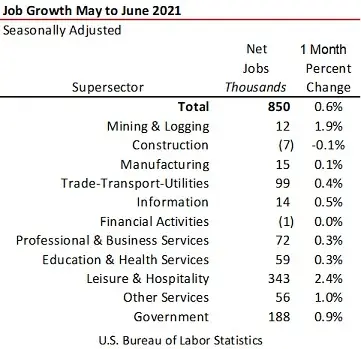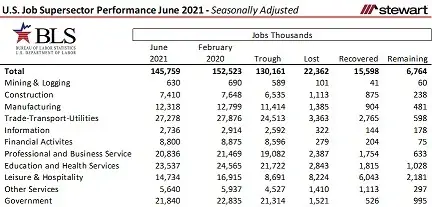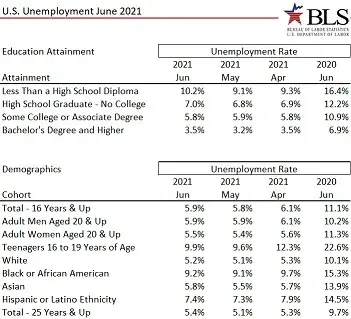Employment Report June 2021 -- Best Job Gains in 10-Months, Recovery Continues But Not Fully Back Yet
The U.S. added 850,000 nonfarm payroll jobs in June 2021 according to the U.S. Bureau of Labor Statistics (BLS).
- Most jobs added monthly since August 2020 when 1.583 million jobs were brought back from the 22.4 million jobs lost in March and April 2020 at the onset of the pandemic
- The 880,000 job expectation from combining ADP’s forecast of 692,000 private sector jobs plus the actual 188,000 Government sector jobs fell slightly short, however
- Bloomberg’s consensus from economists forecast 720,000 added jobs underestimating actual performance
The U.S. has now recovered all but 6.76 million of the 22.4 million jobs lost in March and April 2020. Total employment using seasonally adjusted data from the BLS are shown in the graph. A significant portion of these gains are still stimulus driven, with the $1.9 trillion American Rescue Plan estimated to increase GDP by 4 percent alone in 2021 and another 2 percent in 2022.

The recovery continues to be unequal across the differing Supersectors as defined by the BLS. The following table shows the net change in jobs from May to June 2021 by Supersector, based on seasonally adjusted data. The leader this month in both total and percentage gain was in the Leisure & Hospitality Sector, which added 343,000 jobs in the month for a massive recovery of 2.4 percent.

The Leisure & Hospitality Supersector still has a significant distance to return to pre-pandemic levels as shown in the graph. At the onset of Coronavirus, almost one-in-two jobs were lost in the sector-- 8.2 million from a total 16.9 million jobs in February 2020. Even after the impressive Leisure & Hospitality jobs gains seen in recent months, the sector is still 2.18 million jobs short from pre-pandemic numbers.

The next two tables show Supersector employment metrics. The first details job numbers (thousands of jobs) by Supersector and the second percentages.


Wages have fared well for those that remained employed – except in the Mining & Logging Sector which included Oil & Gas. The next table shows the average hourly wages in June by Supersector from 2019 to 2021. Both the 12-month and 24-month spans saw an increase in hourly wages in all Supersectors. Over the 24-month span, Mining & Logging (which includes oil & gas production) was up the least at 4.3 percent. Greatest gain was in Financial Activities up 11.7 percent. The best paying sector remains Information at an average $44.53 per hour wage rate.

There was no surprise to the slight upturn in the unemployment rate from 5.8 percent in May to 5.9 percent in June given the 26 states that have already ceased or set an end date for the $300 weekly federal unemployment payments. Unemployment rates for education and demographic cohorts are detailed in the next table. The Federal Reserve has stated in the past that an unemployment rate from 5.0 percent to 5.5 percent corresponds to full employment. Both younger and less educated workers continue to bear a greater level of unemployment.

The next two tables detail unemployment rates by Occupation and by Industry & Worker Class. These data are only available in a non-seasonally adjusted basis, so the proper comparison is year-over-year.


To access the monthly BLS jobs report click https://www.bls.gov/news.release/pdf/jolts.pdf
Reiterated is what I said in recent months:
Some of the jobs shed during the pandemic are gone as businesses closed permanently. Other firms changed the way business was done to survive resulting in fewer needed employees. The pandemic and its impact on the economy continues. Those that kept their jobs have generally fared financially well. Yet some others – both people and businesses – are still struggling.
The economy is coming back, but is still short jobs-wise from pre-pandemic levels, even though GDP is forecast by the Congressional Budget Office to hit an all-time high in 2021. They see GDP growing 3.7 percent (adjusted for inflation) in 2021 after being down 2.5 percent in 2020. The CBO expects an average annual GDP growth of 1.7 percent from 2020 to 2030.
This pandemic, however, has yet to run its course and remains a material factor going forward.
Ted
